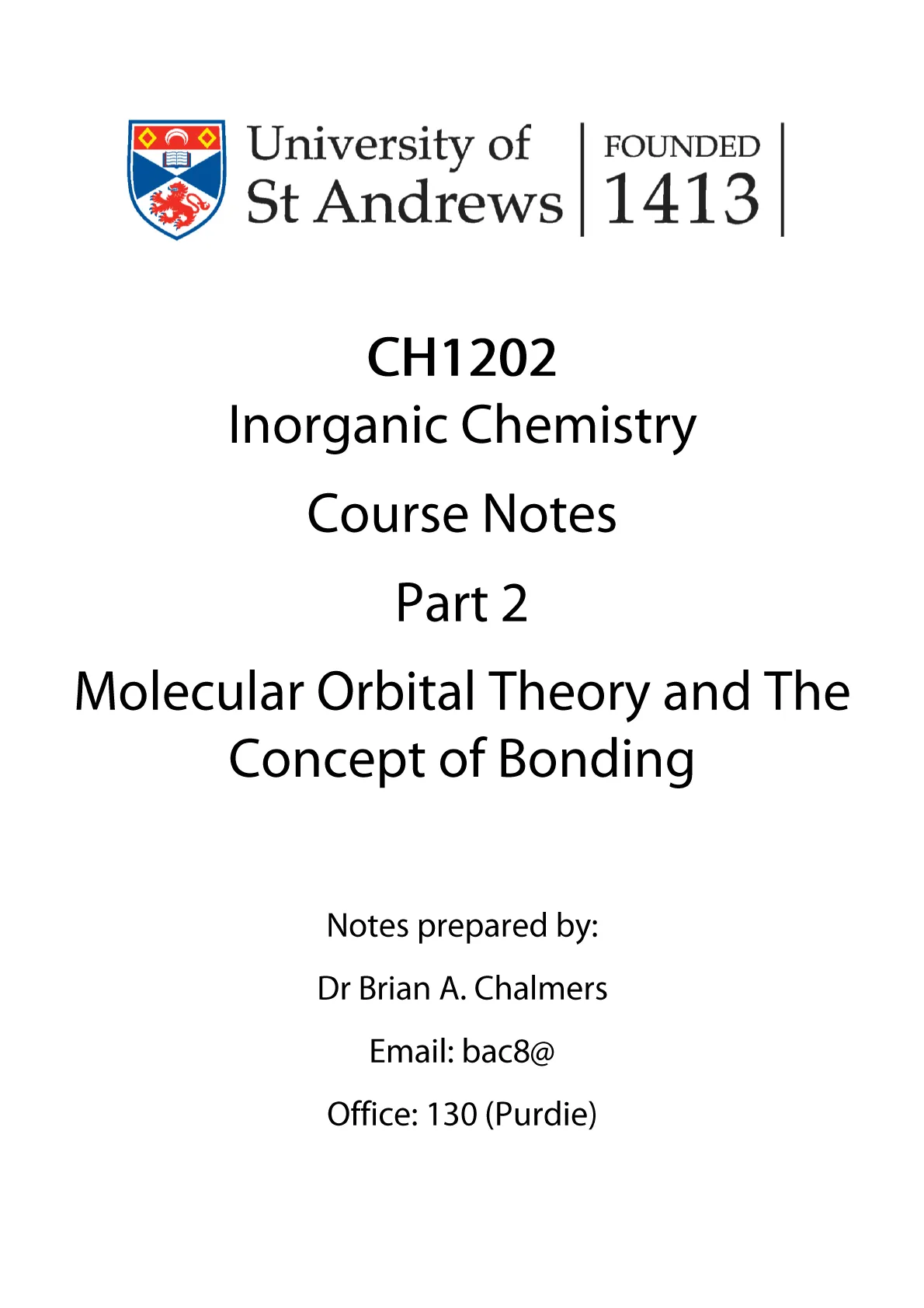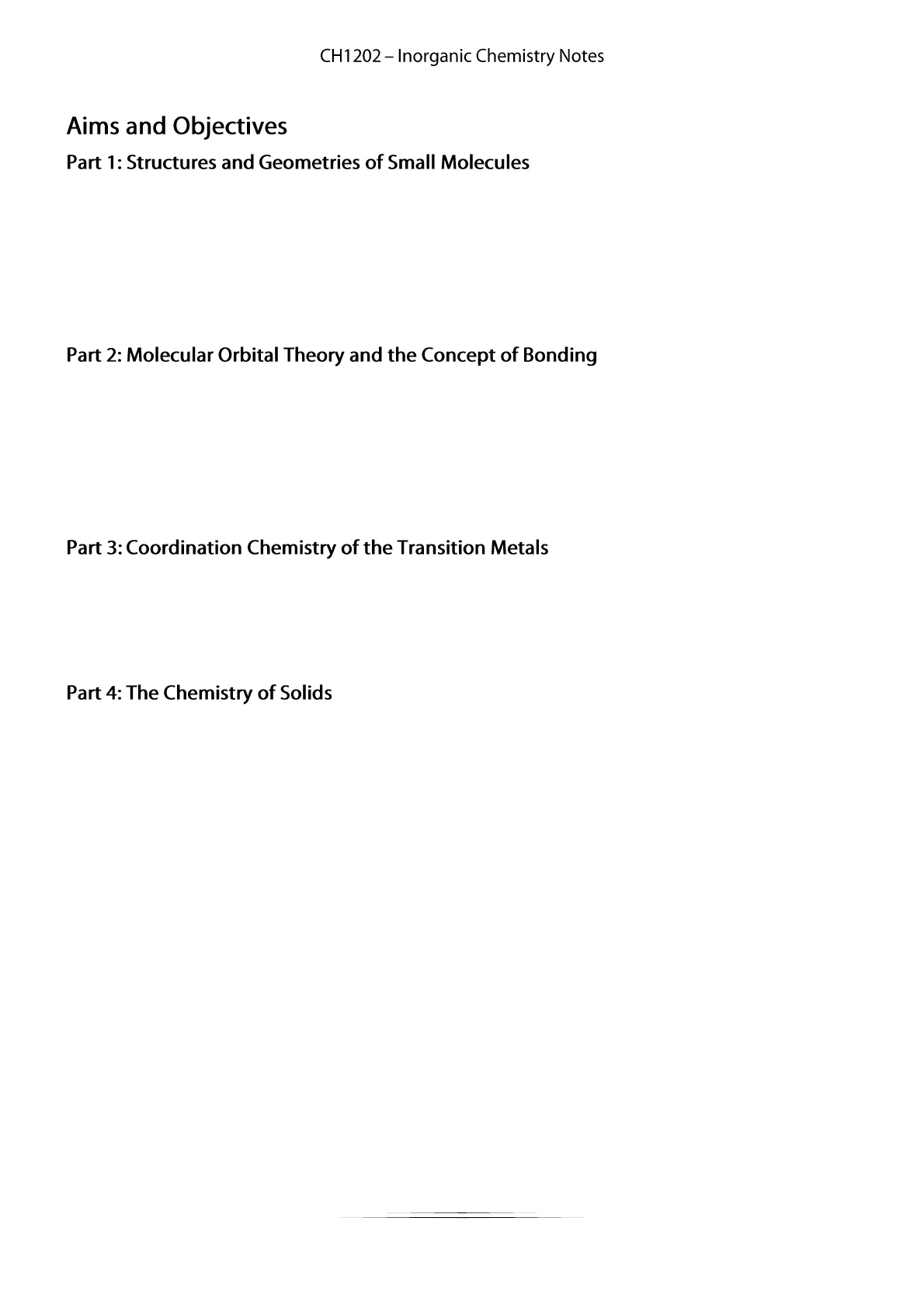Inorganic Chemistry: Molecular Orbital Theory and the Concept of Bonding
Document from University of St Andrews about CH1202 Inorganic Chemistry Course Notes Part 2 Molecular Orbital Theory and The Concept of Bonding. The Pdf, a university-level chemistry resource, delves into molecular orbital diagrams for diatomic and triatomic molecules, interaction between orbitals, and bond order determination.
See more45 Pages


Unlock the full PDF for free
Sign up to get full access to the document and start transforming it with AI.
Preview
Aims and Objectives
Part 1: Structures and Geometries of Small Molecules
- The concept of oxidation states
- Lewis structures
- VSEPR Theory
- Redox Determination
- Descriptive chemistry of Group 1 and Group 17 elements*
- Nuclear Chemistry*
Part 2: Molecular Orbital Theory and the Concept of Bonding
- The Atomic Concept
- Orbital mixing
- MO diagrams of homonuclear diatomic molecules (H2 to F2)
- The concept of s/p mixing
- MO diagrams of heteronuclear diatomic molecules (HF, CO, NO)
- MO diagrams of heteronuclear triatomic molecules (BeH2, CO2)
Part 3: Coordination Chemistry of the Transition Metals
- What is a metal complex?
- Ligands
- Geometry and Isomerism
- Descriptive chemistry of groups 4-11*
Part 4: The Chemistry of Solids
- The structure, properties and composition of solids
- Bonding types
- Why do things crystallise?
- Crystal lattices and symmetry
- The structures of solid elements; packing and properties
- Solid State Syntheses*
- Radius Ratio Rules*
The marked topics (*) are not covered in CH1202, but were taught in CH1401 and CH1402. You will not be examined on these topics in CH1202, but this knowledge will be required for some future modules.
CH1202 - Inorganic Chemistry Notes
2 - Molecular Orbital Theory and The Concept of Bonding
2.1 - The Atomic Concept
The idea of the existence of the atom was first realised when British scientist Joseph J. Thomson discovered the electron in 1897 by passing high electric currents through low pressure gases. He noticed these gases could conduct the electric charge, so concluded something much be 'carrying' the electricity through the gases. These were originally named cathode rays. A few years prior to this, Wilhem Röntgen discovered X-rays (originally named Röntgen rays) and Henri Becquerel discovered radioactivity.
J. J. Thomson also measured the mass of an electron at 9.10938356 x 10-31 kg which, in 1910, lead Robert Millikan (USA) to measure the charge an electron carried as -1.602 x 10-19 Coulombs. He done this by passing drops of oil through charges plates and irradiated them with high energy X-rays. The higher the charge on the particles, the more they are attracted to the upper plate which affects the rate they fall at. All the particles that were observed had charges that were multiples of -1.602 x 10-19. A year earlier, in 1909, Ernest Rutherford (New Zealand) discovered the existence of the proton and measured its mass to be 1.6726219 x 10-27 kg, which is around 2000 times heavier than the electron. Its charge was also measured to be equal but opposite to the electron charge at +1.602 x 10-19 Coulombs. A few years earlier in 1906, Henry Moseley discovered the number of protons is equal to the atomic number, sparking its redefinition.
CH1202 - Inorganic Chemistry Notes
In 1913, Danish Physicist Neils Bohr proposed the first model of the atom, called the Bohr Model (see section 2.1.1). He proposed the protons are at the centre of the atom, with the electrons moving rapidly around the protons in fixed shells. The idea of fixed shells was mainly derived from the knowledge that atomic emission spectra consist of transitions of fixed wavelengths of light (i.e. fixed energy) developed by Max Planck in 1900.
At this point, atoms were thought of a being "hard, impenetrable spheres". A few years later, the Gieger-Marsden Experiment gave some very unexpected yet interesting results.
High energy a-particles were directed at a very thin gold film. Most of the a-particles passed directly through the gold without being deflected or having their paths altered. However, a very small proportion were deflected significantly.
Earlier, in 1905, Albert Einstein published the photoelectric effect and the famous equation, E = mc2, and noted in this that electromagnetic radiation (i.e. light) can be treated as a particle with specific quantised energy called a photon. James Clark Maxwell, of Scotland, proposed the theory of electromagnetism in 1876, and made the connection between light and electromagnetic waves. The results of the Gieger- Marsden experiment and Einstein's photoelectric effect, lead French scientist Louis de Broglie (in 1923) to propose that small particles, such as electrons, could also behave like waves i.e. the theory and concept of wave-particle duality.
Many experiments were carried out to verify this including the 'double-slit' experiment. When light passes through two very closely spaced slits, each slit gives rise to a circular wave radiating from the slit. When the peak of the first wave coincides with the peak of the second wave constructive interference occurs and the amplitudes of the two waves add. In contrast, when the peak of one coincides with the trough of the other, destructive interference occurs and the waves cancel each other out. This was first observed by Thomas Young in the 19th century. However, when small particles, such as electrons, were fired at the double slit, the exact same interference pattern that was caused by two waves was observed.
CH1202 - Inorganic Chemistry Notes
These experiments proved that in some cases, light behaves like waves and in others, like particles. It was also shown that small sub-atomic particles can also be treated like waves. The wave-particle duality of light is counterintuitive but is a fundamental part of modern science.
By the time the neutron was discovered in 1932 by British scientist James Chadwick, the idea of the atom had been well developed. However, the masses of the proton and electron appeared to be different for every element and were rough multiples of each other. This suggest something fundamental was missing. The neutron was very difficult to observe as it is uncharged. Their presence was predicted based on charge to mass ratios in ions. Chadwick discovered the neutron by bombarding lithium, beryllium and boron with a-particles generated from polonium-210. Upon doing this he noticed an unusually penetrating radiation was produced. The radiation was not influenced by an electric field and was originally assumed to be gamma radiation.
It was soon shown by Irene Joliot-Curie and Frederic Joliot-Curie if paraffin, or any other hydrogen- containing compound, was exposed to this "gamma" radiation it ejected protons of very high energy. Chadwick quickly performed a series of experiments that showed that the new radiation consisted of uncharged particles with roughly the same mass as the proton. These particles were neutrons. Chadwick was awarded the Nobel Prize in Physics for this discovery in 1935. In the same year Chadwick reported the first accurate measurement of the mass of the neutron as 1.6749 x 10-27 kg.
Models for atomic nucleus consisting of protons and neutrons were quickly developed by Werner Heisenberg. The origins of B-radiation were explained by Enrico Fermi in 1934. He concluded and proved that a neutron decays to a proton by creating an electron and a neutrino. The neutrino was not officially discovered until 1956, although Fermi did try to report his findings in Nature in 1934, but this was rejected as his theory was "too remote from reality". The 1995 Physics Nobel Prize was awarded to Perl and Reines for the detection of the neutrino and discovery of the tau lepton. Even to this day, the mass of the neutrino is unknown exactly. It is thought to be about one millionth of that of an electron.
CH1202 - Inorganic Chemistry Notes
2.1.1 - The Bohr Model
As mentioned in the previous section, in 1913, Danish Physicist Neils Bohr proposed the first model of the atom, with protons are at the centre and electrons moving rapidly around the protons in fixed shells with the energies defined by:
212mee4 E = n 2 h 2
me is the mass of an electron, e is the charge on an electron, h is Planck's constant (6.626 x 10-34 J.s) and n is an integer (known as a quantum number. In this model, the electrons are believed to orbit the nucleus in a circular pattern, with each level given an integer value (a quantum number, n = 1, 2, 3 ... etc.). As a line in the atomic emission spectrum of hydrogen arises from the transition between two energy levels, the equation is constant with the Rydberg empirical expression.
c -= RH 1 12 n2 1 (Where n1 and n2 are integers and n2 > n1, and RH is the Rydberg constant = 3.29 x 1015 Hz). When n = 1 in the Bohr model, this represents the lowest energy state, closest to the nucleus. Despite the success of the Bohr model, in explaining the atomic spectrum of hydrogen, Bohr's model is unable to explain the spectrum of any other atom, nor could Bohr explain why only certain orbits were allowed. According to classical physics, the orbiting electron should emit electromagnetic radiation and collapse into the proton nucleus. Although the Bohr model was superseded, two key concepts were retained in later theories; the quantisation of energy levels and the quantum numbers.
The first energy level can hold a maximum of two electrons.
The second and third energy levels can each contain up to 8 electrons.
2.1.2 - The Heisenberg Uncertainty Principle and the Schrodinger Equation
Louis de Broglie suggested in 1924 that all matter has wave properties associated with it and that the wavelength (1) is inversely proportional to the mass (m) and velocity (v) of the matter. This seems insane at first to consider everyday objects, such as sofas or golf balls as waves since they have no evidence of wave-like behaviour at all. The inclusion of Planck's constant in the equation, (h = 6.626 x 10-34 J.s) means the wavelength of such heavy objects are unnoticeable.
h λ= - mv
As an example, a bullet weighing 5.00 g travelling at 1000 m s-1 has an associated wavelength of around 1 x 10-34 m. This is far too small to ever be detected since the typical distance between atoms is ca. 1 x 10-10 m, around 1024 times larger. The wave character of very light objects, such as subatomic particles, cannot be ignored unlike those of larger objects.